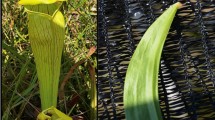Abstract
While investigating the preferences of meadow voles (Microtus pennsylvanicus) toward various coniferous species, we noted they often cut the branches of young trees, and then left them lying on the snow for two days or more before eating them completely. We tested whether this “behavioral manipulation” of a potential food resource resulted in a decrease in the level of secondary metabolites in branches. We found that after being cut for more than three days, the branches of young conifers had significantly less phenolics and condensed tannins. These postmanipulation levels of secondary metabolites were similar to those found in preferred summer food resources. Voles were thus capable of transforming a low-quality resource into one that was more compatible with their feeding patterns and detoxification mechanisms.
Similar content being viewed by others
References
Batzli, G. 1985. Nutrition, pp. 779–781,in R.H. Tamarin (éd.). Biology of New WorldMicrotus, Special Publ. No. 8, The American Society of Mammalogists.
Beart, J.E., Lilley, T.H., andHaslam, E. 1985. Plant polyphenols—secondary metabolism and chemical defense: Some observations.Phytochemistry 24:33–38.
Berger, P.J., Sanders, E.H., Garner, P.D., andNegus, N.C. 1977. Phenolic plant compounds functioning as reproductive inhibitors inMicrotus montanus.Science 195:575–577.
Bergeron, J.M., andJodoin, L. 1987. Defining “high quality” food resources of herbivores: The case for meadow voles (Microtus pennsylvanicus).Oecologia 71:510–517.
Bryant, J.P. 1981. Phytochemical deterrence of snowshoe hare browsing by adventitious shoots of four Alaskan trees.Science 213:889–890.
Bryant, J.P., andKuropat, P. 1981. Antiherbivore defense patterns of taiga forest trees and shrubs. Proceedings of the 32nd Alaska Science Meeting, Fairbanks, Alaska, August 25–27.
Burns, R.E. 1971. Method for estimation of tannin in grain sorghum.Agron. J. 63:511–512.
Byers, R.E. 1974. Susceptibility of apple and peach stems to attack by pine voles.Hort. Sci. 9:90–91.
Cooper, S.M., andOwen-Smith, N. 1985. Condensed tannins deter feeding by browsing ruminants in a South African savanna.Oecologia 67:142–146.
Freeland, W.J., andJanzen, D.H. 1974. Strategies in herbivory by mammals: The role of plant secondary compounds.Am. Nat. 108:269–289.
Hansson, L. 1985. Damage by wildlife, especially small rodents, to North AmericanPinus contorta provenances introduced into Sweden.Can. J. For. Res. 15:1167–1171.
Jokela, J.J., andLorenz, R.W. 1959. Mouse injury to forest plantings in the prairie region of Illinois.J. For. 57:21–25.
Levin, D.A. 1976. The chemical defenses of plants to pathogens and herbivores.Annu. Rev. Ecol. Syst. 7:121–159.
Lindroth, R.L., andBatzli, G.O. 1984. Plant phenolics as chemical defenses: Effects of natural phenolics on survival and growth of prairie voles (Microtus ochrogaster).J. Chem. Ecol. 10:229–237.
Lindroth, R.L., andPajutee, M.S. 1987. Chemical analysis of phenolic glycosides: art, facts, and artifacts.Oecologia 74:144–148.
Lindroth, R.L., Batzli, G.O., andAvildsen, S.I. 1986.Lespedeza phenolics andPenstemon alkaloids: Effects on digestion efficiencies and growth of voles.J. Chem. Ecol. 12:713–728.
Oates, J.F., Swain, T., andZantovska, J. 1977. Secondary compounds and food selection ofColobus monkeys.Biochem. Syst. Ecol. 5:317–321.
Palo, R.T. 1984. Distribution of birch (Betula spp.), willow (Salix spp.) and poplar (Populus spp.) secondary metabolites and their potential role as chemical defense against herbivores.J. Chem. Ecol. 10:499–520.
Price, M., Van Seyor, S., andButier, L.G. 1978. A critical evaluation of the vanillin reaction for tannin in sorghum grain.J. Agric. Food Chem. 26:1214–1218.
Reichardt, P.B., Bryant, J.P., Chausen, T.P., andWieland, G.D. 1984. Defense of winterdormant Alaska paper birch against snowshoe hares.Oecologia 65:58–69.
Sartz, R.S. 1970. Mouse damage to young plantations in southwestern Wisconsin.J. For. 68:88–89.
Sas Institute. 1985. SAS User's Guide: Statistics, 5th ed. Cary, North Carolina.
Sinclair, A.R.E., Krebs, C.J., andSmith, J.N.M. 1982. Diet quality and food limitation in herbivores: the case of the snowshoe hare.Can. J. Zool. 60:889–897.
Sinclair, A.R.E., Jogia, M.K., andAndersen, R.J. 1988. Camphor from juvenile white spruce as an antifeedant for snowshoe hares.J. Chem. Ecol. 14(6): 1505–1514.
Singleton, V.L., andRossi, J.A., Jr. 1966. Colorimetry of total phenolics with phosphomolybdic-phosphotungstic acid reagents.Am. J. Enol. Vitic. 16:144–158.
Swain, T. 1979. Phenolics in the environment.Recent Adv. Phytochem. 12:617–640.
Tahvanainen, J., Helle, E., Julkunen-Tiito, R., andLavola, A. 1985. Phenolic compounds of willow bark as deterrents against feeding by mountain hare.Oecologia 65:319–323.
Wysolmerski, J.C., Byers, R.E., andCummings, J.N. 1980. Laboratory evaluation of someMalus clones for susceptibility to girdling by pine voles.J. Am. Hortic.Sci. 105:675–677.
Author information
Authors and Affiliations
Rights and permissions
About this article
Cite this article
Roy, J., Bergeron, J.M. Branch-cutting behavior by the vole (Microtus pennsylvanicus). J Chem Ecol 16, 735–741 (1990). https://doi.org/10.1007/BF01016484
Received:
Accepted:
Issue Date:
DOI: https://doi.org/10.1007/BF01016484




